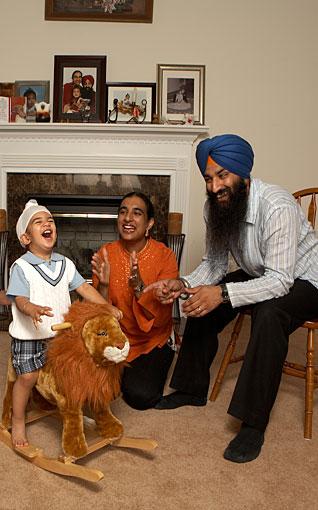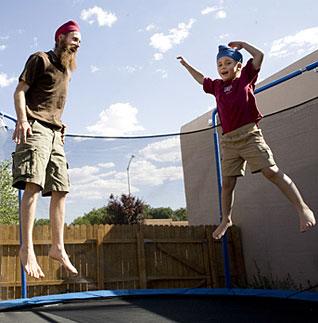Faith
Manhattan's Young TUrban Professionals
by SAMUEL G. FREEDMAN
Mandeep Singh was having dinner with a friend in Queens (New York, U.S.A.) several years ago when the subject turned to their common religion, Sikhism.
Mandeep had grown up in India unquestioningly embracing the faith of his parents. As a college student in Delhi, India, he attended a gurdwara with a congregation well into the hundreds and a paid staff of a dozen, leaving him feeling devout yet somehow peripheral.
By this time, working as a technology consultant in New York, Mandeep had a different sensation, not exactly unsettled but acutely curious. So when his friend mentioned that a local Sikh association had a page on Facebook, not exactly the place Mandeep was expecting to find religious direction, he eagerly clicked to it.
The information there, posted by the Manhattan Sikh Association, included one particular phrase that piqued Mandeep's interest: "youth gurdwara." It led him, on a Thursday night in late 2007, to the rented multipurpose room of a luxury condominium building in Battery Park City.
There, in a setting usually deployed for residents' meetings and children's birthday parties, white cloths covered the carpet and white sheeting obscured the mirrors. At the far end of the room sat the throne - palki - that held the Sikh scripture, the Guru Granth.
What most caught Mandeep's eye, though, were the other members of the congregation, or sangat. They were, like him, young professionals, the BlackBerry crowd, and as the worship service, or divan, proceeded over the next several hours, these amateur clerics took turns leading the reading of sacred poetry and the singing of devotional hymns.
Ever since that first visit, Mandeep has been a regular participant in the Manhattan Sikh Association's divan, which is held the third Thursday of each month. In so doing, he forms one part of the Sikh version of what religion scholars call the emergent movement, a growing trend toward small, nimble, bottom-up, laity-led congregations that especially attract young adults.
In evangelical Christian circles, the movement includes the scores of microcongregations of the Journey. The Jewish version, known as minyanim, or prayer groups, turns up in Brooklyn's Altshul and Washington's Tikkun Leil Shabbat, among other places.
And for about 300 of the estimated 500,000 Sikhs in the United States, the divan in Battery Park City is not your chacha's - in Punjabi, your uncle's - gurdwara.
"The one thing you feel here is a lot of young blood," Maneep Singh, now 28 and working as a contracts analyst for Bloomberg LLP, said after last Thursday's divan. "Since everyone is your age, you can ask the naïve questions, and by asking, you can learn the underlying principles. It encourages you, because it is being done by your peers."
Amit Singh Guleria offered a similar view. At the age of 26, commuting into Manhattan daily from central New Jersey, working long hours as a construction engineer, Amit had sought a religious experience that fit both his generation and his lifestyle.
"When you're living the life of someone in your 20s, it gives you a different energy," Amit said. "When you go to a traditional gurdwara, you feel more like an observer than a participant. Here, the onus is on us. And that's a responsibility we want to have."
The route to such responsibility began in a Greenwich Village apartment in early 2007. The apartment belonged to Pritpal Singh Kochhar, who headed a foundation for Sikh culture and also led international trips for the Sierra Club.
The population of Sikhs in the United States was steadily rising, but a spiritual leader of the American community, Harbhajan Singh Yogi, had died in 2004. Pritpal believed that it was vital for Sikhs to continue building new congregations in the manner he had.
Using e-mail, social networking and old-fashioned word-of-mouth, Pritpal put together the initial 15 members of the Manhattan Sikh Association. In October 2007, it held the first divan in Battery Park City, drawing about 50 people.
"We were wondering, Who are these people? Where are they coming from?" recalled Ms Simi Singh, 43, a product manager at JPMorgan Chase.
The answer to Simi's rhetorical question is that they were coming, and still are coming, from the ranks of the young, well-educated and upwardly mobile. The divan includes doctors, lawyers, bankers, engineers, computer consultants, graduate students and at least one chef. Perhaps half are the American-born children of immigrants, half are immigrants themselves, and either way they have a foot apiece in tradition and dynamism.
For while news media coverage of Sikhs in the United States has tended to focus on controversy - bias crimes against Sikh men, who are mistaken for Muslims because of their turbans, or civil rights suits by Sikhs to allow men to wear turbans and keep beards in various workplaces - the more prevalent, day-in-day-out experience is of finessing the balance between accomplishment and assimilation.
The monthly divan deftly navigates between heritage and modernity. When worshippers enter with bare feet and covered head, when they bow before the scripture, they are fulfilling centuries-old obligations. The service follows the time-honoured sequence of readings, hymns, a discourse called katha, the distribution of the sweet sacramental food - karah parshad - and finally the sharing of a communal meal known as langar.
But the words of the liturgy are projected from a laptop, both translated into English and transliterated phonetically for the many members who cannot read Gurmukhi, the script of the Sikh religious texts. One set of projections carries the logo, "Sikhi to the Max."
The worship leaders, while literate in Gurmukhi and fluent in spoken Punjabi, are not professionals trained in one of India's Sikh religious colleges. A shifting array of volunteers play the tabla and harmonium and sing the hymns, tasks given over in more institutional gurdwaras to specialists or paid professionals.
And while a typical divan in a conventional gurdwara might last four or five hours, this one held to its announced itinerary, finishing in two.
Its effect was no less for the punctuality. "You get peace of mind here," said Mandeep Singh. "Even after a day of work, you get the meditative effect."
 
[Courtesy: The New York Times]
August 22, 2009
Conversation about this article
1: Harnaam (Toronto, Ontario, Canada), August 23, 2009, 12:13 AM.
This is a great story. Real pleasure to read. However, I have one concern I'd like to share with the author: The idea of the educated/non-educated should not matter when in sangat. We do not (or should not...) judge people on their education, background, etc. In Sikhism, we are taught that everyone is equal( no matter the cast, creed, or background). So why should it matter whether the people in your gurdwara are illiterate, less educated, or all studying for their Ph.D.s? Please do not consider less educated people, or older people from the past generation any different from yourself, or any less valuable as neighbours or as sangat. If you are concerned with the local gurdwara's parchaar, I don't believe that opening your own gurdwara is the answer, rather take part in the sangat and share your concerns with the sangat. This young sangat should in fact be going to the gurdwaras and taking over as the next generation. Excluding yourself from the sangat isn't the answer. P.S. - 'Sikhi To The Max' is now standard fare in many gurdwaras across North America.
2: Dharamveer Singh (Mumbai, India), August 24, 2009, 8:49 AM.
Why do we always think that when something is initiated, there is something wrong with it? The learning I would take from this artice is that if I presently consider Amrit a baptism for the old age and Gurbani tough to understand, then I need to change my view on it. I would also encourage my friends who consider the rehat to be followed after amrit difficult, to take a look at how people around the world are doing the job. I do not completely agree with Harnaam ji's concerns as there is no mention of only highly educated people being allowed to participate in the divan. However, I do agree that additionaly they should become part of the sangat in the existing nearest gurdwara. As a suggestion to these professional youth sangat, I would say that you can try finding answers for your questions from the ragis and granthis of all the gurdwaras in your town. They are people who have dedicated their life towards the service of God and spend more time reading the Guru Granth than most of us. My only message to the Sikhs around the world: "Greet any Sikh you come across anytime anywhere and try and help needy Sikhs." Je Sikh nu Sikh na maare, Eh quom kade na haare!
3: Chintan Singh (San Jose, California, U.S.A.), August 24, 2009, 1:47 PM.
We have a very similar situation here in the San Francisco Bay Area. About seven years ago, a few young couples started the monthly kirtan program on the third saturday evening of each month. The group was a mixed bag of immigrants and children of immigrants - all seeking to understand Sikhi better and wanting to grow in their spiritual quests. The divan setup, kirtan, ardaas, hukamnama, sukh aasan and langar, all were done by volunteers. That program is still continuing after seven years but now with an average attendance of about 30-40 families, i.e. about 100 individuals. The best part: there are now children performing kirtan in this program. The age group of children varies from 3 yrs to about 12. The children's kirtan is done in the first hour and then two volunteer moms take the kids to another room to engage them in a learning activity while the adults perform kirtan for an hour. As a reward for participation in the kirtan as well as in the learning activity, the kids are given candies and some goodies. After the adults' kirtan, the kids are brought back in the divan for the final group shabad. Due to the fact that the program has attracted so much attendance and it is no longer possible to host it in a small home, a few times in the recent past the program has been held as a private program in a gurdwara. This has been partially successful. I say this to point out that usually our gurdwaras operate in a traditional manner and there isn't room to make mistakes while performing kirtan, reading the Guru's hukamnama or doing ardaas and therefore can be intimidating to younger folks who have been away from a traditional Sikh household for a while. That is one of the reasons these emergent movements and 'lay-person' driven programs are becoming more and more popular. And yes, we use 'SikhiToTheMax' too!
4: Bhupinder Singh Ghai (New Delhi, India), August 25, 2009, 3:56 AM.
We have done exactly the same thing in Greater Kailash II, the so-called posh/elite colony of Delhi. I am glad youngsters are taking the initiative and are not dependednt on tradiotional raagis, granthis, etc. The passion with which these youngsters do seva is infectious. On a diiferent note, I am not sure if we have a regular gurdwara in Manhattan. Whenever I stay in Manhattan for business, I miss going to the gurdwara. Can anybody guide me?






